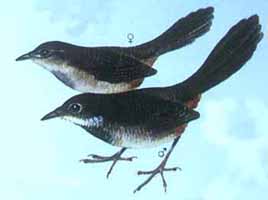 The
Scrub-birds are a small Australasian family composed of just two species
in the genus Atrichornis: the Rufous Scrub-bird (left in
a great photo by Michael Morcombe) and the Noisy Scrub-bird
(painting
below). Both are difficult birds to observe, so Michael Morcombe's photo
of one in full song is quite wonderful. He tells me he took this shot in
1968 when traveling about Australia, photographing birds, in a trailer
with a wife and 3 kids! [see his Australian
website for more on his photography; he also has a new field guide
out for the continent]. The
Scrub-birds are a small Australasian family composed of just two species
in the genus Atrichornis: the Rufous Scrub-bird (left in
a great photo by Michael Morcombe) and the Noisy Scrub-bird
(painting
below). Both are difficult birds to observe, so Michael Morcombe's photo
of one in full song is quite wonderful. He tells me he took this shot in
1968 when traveling about Australia, photographing birds, in a trailer
with a wife and 3 kids! [see his Australian
website for more on his photography; he also has a new field guide
out for the continent].
Scrub-birds are an ancient Australian family that are apparently most closely related to Lyrebirds (Sibley & Ahlquist 1990). Rufous Scrub-bird is found only in thick undergrowth in forests of coastal eastern Australia. The Noisy Scrub-bird (below) is limited to thick coastal scrub in extreme southwestern Australia where it is endangered. |
 My
own experience with scrub-birds is limited to one visit to one site two
decades ago (I'm standing at the spot, right). Here I saw one Rufous Scrub-bird
and heard one or two more. The habitat was thick undergrowth in wet Antarctic
Beech (Nothofagus) forest in Lamington Nat'l Park, s. Queensland.
A couple friends and I were staying at O'Reilly's — an absolutely fantastic
spot — and got directions to this specific site some 4 miles distant in
the forest. We left pre-dawn one day on the 8-mile roundtrip hike with
only a tiny tape recorder and no tapes. Fortunately, though, scrub-birds
were singing in the dense thickets and I was able to get enough on the
tape to manage a response and one close view. Since there was no chance
of photographing the birds in the gloom, I settled for this shot of me-among-the-trees,
successful in the quest. The 8-mile hike meant we were back too late for
breakfast, but at O'Reilly's they feed you every couple hours anyway (morning
tea, afternoon tea, etc., etc.), so we didn't even go hungry.... My
own experience with scrub-birds is limited to one visit to one site two
decades ago (I'm standing at the spot, right). Here I saw one Rufous Scrub-bird
and heard one or two more. The habitat was thick undergrowth in wet Antarctic
Beech (Nothofagus) forest in Lamington Nat'l Park, s. Queensland.
A couple friends and I were staying at O'Reilly's — an absolutely fantastic
spot — and got directions to this specific site some 4 miles distant in
the forest. We left pre-dawn one day on the 8-mile roundtrip hike with
only a tiny tape recorder and no tapes. Fortunately, though, scrub-birds
were singing in the dense thickets and I was able to get enough on the
tape to manage a response and one close view. Since there was no chance
of photographing the birds in the gloom, I settled for this shot of me-among-the-trees,
successful in the quest. The 8-mile hike meant we were back too late for
breakfast, but at O'Reilly's they feed you every couple hours anyway (morning
tea, afternoon tea, etc., etc.), so we didn't even go hungry....
Both species of scrub-bird are sedentary and live only in isolated patches. Blakers et al. (1984) say that "even when Europeans arrived, the distribution of Rufous Scrub-bird was that of a relict species, fragmented populations surviving in patches of suitable country." It requires a dense layer of ground cover at least 1 meter high, abundant leaf litter (in which they feed), and a "moist microclimate at ground level." This habitat is found only in the coastal mountains of s. Queensland and n. New South Wales. At the time of the Australian bird atlas (Blakers et al. 1984), Noisy Scrub-bird was known only from Mt. Gardner in Two People Bay Nature Reserve in Western Australia. It had been thought to be extinct, but was rediscovered in 1961. Both species were threatened by habitat loss and, especially, fires. "Fires started by early settlers and forest managers became too frequent to allow the bird's invertebrate food supply to survive in the forest, though nesting areas were little damaged .... Experience suggests that the heath and forest needs to be free from fire for 8-10 years to regenerate a sufficiently deep litter layer to support a Noisy Scrub-bird population" (Blakers et al. 1984). Populations of Noisy Scrub-bird have slowly increased with management and protection from fire. Territorial males were estimated at only 40-45 birds in 1965, but these numbers increased to a total population estimate (including the singing males) of perhaps 400 birds by 1985 (Simpson & Day 1996). Active intervention and the establishment of additional sites, through translocation and recolonization, has now upped the population level to perhaps 1500 birds (Birdlife International 2002). |
